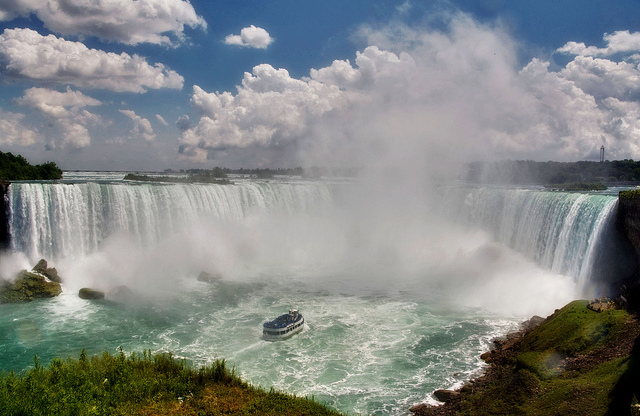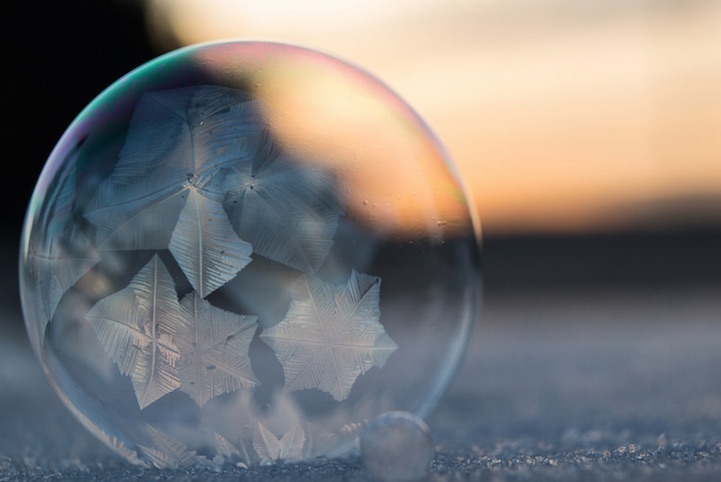1. Victoria Falls, Zambia/Zimbabwe
Image by MAZZALIARMADI.IT
Explorer David Livingstone could be accused of dampening expectations by naming these falls after England’s doughy queen: dour and staid they’re not. The locals, though, got it spot on, calling the falls Mosi-oa-Tunya – ‘the smoke that thunders’. They’re monstrously loud, and the mist rising as the Zambezi River plunges 108m into the gorge below – over 12,000 cubic metres per second at its heaviest flow – rises in vast clouds. See them from above, from below, from Knife Edge Point, from the Devil’s Pool and from Cataract View, at sunrise and by moonlight – just make sure you see them.
Although flow is greatest between April and June, the best time for sunset photography is arguably October to December, when spray is not too heavy.
2. Niagara Falls, USA/Canada

Image by Artur Staszewski
Let’s hear you shout it: Waterfalls are fun! Louder! And again! It’s fortunate that Niagara is so truly awesome (up to 2800 cubic metres per second awesome, since you ask) or the various and extremely numerous shots of
commercialised hokum might overwhelm the sight. But it is, and they don’t – in fact, you’ll probably visit, climb or ride several of the attractions to drink in many facets of the falls. Top of the list has to be a voyage on the Maid of the Mist, the 11th incarnation of the venerable boat that first sailed into the spray in 1846.
Experience the falls on the Maid of the Mist, which sails from April to October.
3. Reichenbach Falls, Switzerland
Image by Mike Knell
Elemental, my dear Watson! Set among the deep gorges and rugged peaks of Switzerland’s Bernese Oberland, the Reichenbachfälle seem appropriately dramatic as the backdrop for the final stand of Sherlock Holmes. It was at the roaring 250m-high cascades near Meiringen that the famous detective tussled with his arch-enemy, Professor Moriarty, before both tumbled into the cataract in the 1891 tale The Final Problem. Today, Holmes fans flock to the falls, hiking over the top and down to the plaque marking the ledge where the fictional fight is believed to have been set.
For an atmospheric approach, catch the historic cable railway alongside the falls, running from Willingen mid-May to early October.
4. Kaieteur Falls, Guyana
Image by sorenriise
These remote falls may not be the highest, the heaviest or the most famous – but they’re probably the wildest. Secreted away in the lush interior of Guyana – hardly an over-touristed neighbourhood – the Potaro River plummets 250m from a sandstone plateau. On the trail to the falls you might spot vivid blue butterflies, scarlet birds and the golden dart-poison frog; listen for screeching howler monkeys. Then crawl to the edge of the precipitous overhang, and look down at the roaring curtain, with white-collared swifts darting out from behind the cascade. Now, that’s adrenalin.
The falls can be reached on charter flights from Guyana’s capital, Georgetown, or an epic multi-day overland journey involving minibuses, boats and trekking.
5. Iguazú Falls, Argentina/Brazil
Image by SF Brit
Historically, Argentina and Brazil haven’t always been the best at sharing; in fact, they’re usually up for a scrap, whether it’s over land (Uruguay, say) or soccer honours. But at Iguazú – Iguaçu to the Brazilians – the falls to end all falls are apportioned between them. OK, so the biggest drop is a ‘mere’ 82m – but with a staggering 275 cataracts extending for 2.7km along the Iguazú River, the combined might is jaw-dropping. And deafening: don your waterproofs and stroll to the lookout beneath the Garganta do Diabo (Devil’s Throat) to feel the raw power of the cascades.
Brazil’s Parque Nacional do Iguaçu is open 9am to 5pm, later in summer; Argentina’s Parque Nacional Iguazú is open 8am to 6pm.
6. Détiān Falls, China
Image by jankgo
What is it about waterfalls that encourages pride that verges on ludicrous? Hence Détiān is proclaimed ‘the world’s second-largest waterfall along a national border’ – the gushing 200m-long stretch of cascades straddles China‘s Guǎngxī province and northern Vietnam (though China gets most of the flow). But you don’t come here for the stats, or the tremendous roar of the rushing water, or for the fun of snapping a photo of yourself at the
border marker. You come because it’s gasp-inducingly beautiful: a verdant vision framed by looming karst outcrops and serene rice paddies.
Midsummer is the best time to appreciate the power of the flow; avoid winter, when the falls are relatively thin streams and fog dominates.
7. Gullfoss, Iceland
Image by aschaf
Iceland is where good geography teachers go when they die: a geological wonderland, its unique otherworldly landscapes go some way to explaining why most Icelanders believe in elves and goblins. Huge glaciers cover over a tenth of the country, hot water spurts at the eponymous Geysir, technicolour mountains loom in the interior, geothermal springs steam – and waterfalls cascade. Gullfoss is a multi-stepped affair that surges down
into a mighty gash carved into the land; magical when the sun sparks rainbows into life, it’s arguably even more enchanting in winter, when snow glistens and rime coats the rocks all around with a sparkling shell.
Gullfoss is easily reached from Reykjavík on a Golden Circle tour, or by bus with Reykjavík Excursions.
8. Sutherland Falls, New Zealand
Image by swifant
Unsurprisingly, in the ‘Land of the Long White Cloud’ it rains a fair bit, especially on the wet west coast of the South Island. After the frequent downpours, New Zealand‘s many cataracts gush even more wildly. Milford Sound, that most photogenic fjord, is renowned for the falls streaming down its sides. The best is on the approach, accessible only by hiking the four-day, 53.5km Milford Track: Sutherland Falls, a 580m-high torrent tumbling from a lake perched on the valley walls. If the sun shines, wonderful; if the rain pours – and it probably will – better still.
Walkers on the Milford Track must book places in huts along the route – see www.doc.govt.nz. From October to April you must hike south to north.
9. Jim Jim Falls, Australia
What’s more of a thrill: floating in a remote plunge pool while gazing up at a 215m-high cascade dashing over rust-red rock cliff s? Or wondering whether a 5m-long prehistoric reptile is about to sink its jagged fangs into your leg? At Jim Jim Falls, deep in Kakadu National Park in Australia’s Northern Territory, you get both: a rufty-tufty 4WD track, then a 1km scramble along a rugged trail, leads to this spectacular outpouring. But before you dive into the swimming hole, so tantalisingly cool in the heat of the outback, ask local advice: saltwater crocodiles have been known to lurk here.
Visitors to Kakadu must pay a A$25 park fee; passes can be bought at centres in Darwin, Katherine and the park itself.
10. Angel Falls, Venezuela
Image by misssharongray
Spoiler alert: romantics, look away right now. The world’s highest single-drop falls (979m high in total, with an 807m plunge) are not named for some celestial being – though the sight of this white ribbon plummeting down the side of the mist-cloaked, flat-topped tepui is almost heavenly. No, the moniker honours aviator Jimmie Angel, who in 1933 became the first to overfly the falls. The local Pemón people are more poetic, recognising the falls’ breathtaking height – so tall that in the dry season much of the water evaporates before reaching the bottom – with the name Kerepakupai merú: ‘falls of the deepest place’.
Several operators in nearby Canaima offer overflights and two- or three-day tours in motorised dugout canoes, usually running from May or June to November
(via lonelyplanet)











